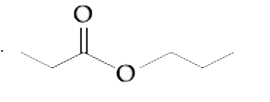An organic compound (A) (molecular formula was hydrolysed with dil . to give carboxylic acid (B) and an alcohol (C). 'C' gives white turbidity immediately when treated with anhydrous and conc. HCl . The organic compound (A) is




To solve the problem step by step, we need to analyze the information given in the question and the implications of the reactions described.
Step 1: Identify the compound A
The molecular formula of compound A is given as C6H12O2. This formula suggests that A could be an ester, as it can hydrolyze to form a carboxylic acid and an alcohol.
Hint: Look for functional groups that can yield both a carboxylic acid and an alcohol upon hydrolysis.
Step 2: Hydrolysis of compound A
When compound A is hydrolyzed with dilute H2SO4, it produces a carboxylic acid (B) and an alcohol (C). Since A is likely an ester, the hydrolysis reaction can be represented as:
RCOOR′+H2O→RCOOH+R′OH
where RCOOR′ represents the ester.
Hint: Remember that esters hydrolyze to form alcohols and carboxylic acids.
Step 3: Analyze the alcohol C
The problem states that alcohol C gives white turbidity immediately when treated with anhydrous ZnCl2 and concentrated HCl. This reaction is indicative of the Lucas test, which is used to differentiate between primary, secondary, and tertiary alcohols. Only tertiary alcohols give immediate turbidity in this test.
Hint: Recall the characteristics of the Lucas test and which types of alcohols react quickly.
Step 4: Determine the structure of alcohol C
Since alcohol C gives immediate turbidity, it must be a tertiary alcohol. Therefore, we can conclude that the hydrolysis of compound A must yield a tertiary alcohol.
Hint: Focus on the structure of potential alcohols that could be formed from the hydrolysis of an ester.
Step 5: Identify the correct ester (compound A)
Now, we need to look at the options provided (not listed here) and determine which ester could yield a tertiary alcohol upon hydrolysis. The only option that fits this criterion will be the correct answer.
Hint: Check each option to see if hydrolysis leads to a tertiary alcohol.
Conclusion
After analyzing the options, we find that the correct compound A is the one that, when hydrolyzed, yields a tertiary alcohol and a carboxylic acid.
Final Answer: The organic compound (A) is the ester that produces a tertiary alcohol upon hydrolysis.
The molecular formula of compound A is given as C6H12O2. This formula suggests that A could be an ester, as it can hydrolyze to form a carboxylic acid and an alcohol.
When compound A is hydrolyzed with dilute H2SO4, it produces a carboxylic acid (B) and an alcohol (C). Since A is likely an ester, the hydrolysis reaction can be represented as:
RCOOR′+H2O→RCOOH+R′OH
where RCOOR′ represents the ester.
The problem states that alcohol C gives white turbidity immediately when treated with anhydrous ZnCl2 and concentrated HCl. This reaction is indicative of the Lucas test, which is used to differentiate between primary, secondary, and tertiary alcohols. Only tertiary alcohols give immediate turbidity in this test.
Since alcohol C gives immediate turbidity, it must be a tertiary alcohol. Therefore, we can conclude that the hydrolysis of compound A must yield a tertiary alcohol.
Now, we need to look at the options provided (not listed here) and determine which ester could yield a tertiary alcohol upon hydrolysis. The only option that fits this criterion will be the correct answer.
After analyzing the options, we find that the correct compound A is the one that, when hydrolyzed, yields a tertiary alcohol and a carboxylic acid.
Topper's Solved these Questions
Similar Questions
A group C6H12O2 which react with H2SO4 and gives carboxylic acid B and alcohol C. C react with ZnCl2 and give white turbidity readily. Identify the structure of A.
View SolutionAn organic compound (A) (molecular formula C8H16O2) was hydrolysed with dilute sulphuric acid to give a carboxylic acid (B) and an alcohol (C ). Oxidation of (C ) with chromic acid produced (B). (C ) on dehydration gives but-1-ene. Write equations for the reactions involved.
View Solution
Knowledge Check
A compound (X) having molecualr formula C4H8O2 is hydrolysed by water in presence of an acid to give a carboxylic acid (Y) and an alcohol (Z). (Z) on oxidation with chromic acid gives (Y), (X), (Y) and (Z) are
A X Y ZCH3COOCH3CH3COOHCH3OHB X Y ZCH3COOC2H5CH3COOHC2H5OHC X Y ZC2H5COOCH3C2H5COOHC2H5OHD X Y ZCH3COOC2H5C2H5COOHCH3OHWhich of the following alcohols do not give white turbidity on treatment with HCl/ZnCl2 ?
ACH3CH2OHB CN≡C−CH∣CH3−OHDCH3−CH3∣C∣CH3−OH
CN≡C−CH∣CH3−OHDCH3−CH3∣C∣CH3−OH
Compound (X) having molecular formula C6H12Cl2 on hydrolysis gives a ketone. Therefore (X) will be
View SolutionAn organic compound with molecular formula C6H12 upon ozonolysis gives only acetone as the product. The compound is :
View SolutionA liquid (X) having a molecular formula C6H12O2 is hydrolysed with water in the presence of an acid to give a carboxylic acid (Y) and an alcohol (Z). Oxidation of (Z) with chrome acid gives (Y) . What are the structures of (X),(Y), and (Z) ?
View SolutionAn organic compound (A) (molecular formula C8H16O2) was hydrolysed with dilute sulphuric acid to give a carboxylic acid (B) and an alcohol (C ). Oxidation of (C ) with chromic acid produced (B). (C ) on dehydration gives but-1-ene. Write equations for the reactions involved.
View SolutionAn organic compound (A) (molecular formula C8H16O2) was hydrolysed with dilute sulphuric acid to give a carboxylic acid (B) and an alcohol (C ). Oxidation of (C ) with chromic acid produced (B). (C ) on dehydration gives but-1-ene. Write equations for the reactions involved.
View SolutionAn organic compound (A) (molecular formula C8H16O2) was hydrolysed with dilute sulphuric acid to give a carboxylic acid (B) and an alcohol (C ). Oxidation of (C ) with chromic acid produced (B). (C ) on dehydration gives but-1-ene. Write equations for the reactions involved.
View Solution